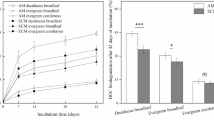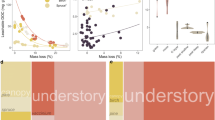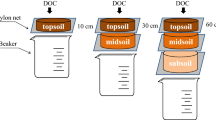Abstract
Background and aims
Litter-derived dissolved organic carbon (DOC) biodegradation is critical to forest ecosystem structure and function. However, it is unclear whether mixing overstory and understory litter-derived DOC could produce non-additive effects on biodegradation in forests.
Methods
We extracted DOC from leaf litter of two coniferous trees, four broadleaf trees, and four understory ferns in subtropical forests and used a laboratory incubation method to measure pure and mixed overstory and understory litter-derived DOC biodegradation. The purposes were to assess the interspecific patterns of litter-derived DOC biodegradation between overstory trees and understory ferns, and then examine the non-additive effects of mixing overstory and understory litter-derived DOC on biodegradation.
Results
Litter-derived DOC biodegradation of understory ferns was comparable to that of overstory broadleaf trees, but higher than that of overstory coniferous trees. Mixing overstory and understory litter-derived DOC produced non-additive effects on biodegradation in all 24 DOC mixtures. Specifically, synergistic effects were observed in 22 DOC mixtures, and antagonistic effects occurred in the other two DOC mixtures. Non-additive effects on DOC biodegradation were positively related to the interspecific differences in DOC:dissolved total phosphorus ratio and DOC aromaticity, respectively, and exhibited no significant relationship with the interspecific differences in DOC:dissolved total nitrogen ratio.
Conclusions
Non-additive effects are common during microbial degradation of overstory and understory litter-derived DOC mixtures, and trait dissimilarity among component DOC sources drives the directions and magnitudes of non-additive effects on biodegradation in subtropical forests.


Similar content being viewed by others
References
Barantal S, Schimann H, Fromin N, Hattenschwiler S (2014) C, N and P fertilization in an Amazonian rainforest supports stoichiometric dissimilarity as a driver of litter diversity effects on decomposition. P Roy Soc B–Biol Sci 281:20141682
Barbier S, Gosselin F, Balandier P (2008) Influence of tree species on understory vegetation diversity and mechanisms involved–a critical review for temperate and boreal forests. Forest Ecol Manag 254:1–15
Bolan NS, Adriano DC, Kunhikrishnan A, James T, McDowell R, Senesi N (2011) Dissolved organic matter: biogeochemistry, dynamics, and environmental significance in soils. Adv Agron 110:1–75
Chen Y, Cao J, Zhao J, Wu J, Zou X, Fu S, Zhang W (2019) Labile C dynamics reflect soil organic carbon sequestration capacity: understory plants drive topsoil C process in subtropical forests. Ecosphere 10:e02784
Cotrufo MF, Soong JL, Horton AJ, Campbell EE, Haddix ML, Wall DH, Parton WJ (2015) Formation of soil organic matter via biochemical and physical pathways of litter mass loss. Nat Geosci 8:776–779
Don A, Kalbitz K (2005) Amounts and degradability of dissolved organic carbon from foliar litter at different decomposition stages. Soil Biol Biochem 37:2171–2179
Ebina J, Tsutsui T, Shirai T (1983) Simultaneous determination of total nitrogen and total phosphorus in water using peroxodisulfate oxidation. Water Res 17:1721–1726
García-Palacios P, Shaw EA, Wall DH, Hättenschwiler S (2017) Contrasting mass-ratio vs. niche complementarity effects on litter C and N loss during decomposition along a regional climatic gradient. J Ecol 105:968–978
Gessner MO, Swan CM, Dang CK, McKie BG, Bardgett RD, Wall DH, Hättenschwiler S (2010) Diversity meets decomposition. Trends Ecol Evol 25:372–380
Guggenberger G, Kaiser K (2003) Dissolved organic matter in soil: challenging the paradigm of sorptive preservation. Geoderma 113:293–310
Hagedorn F, Machwitz M (2007) Controls on dissolved organic matter leaching from forest litter grown under elevated atmospheric CO2. Soil Biol Biochem 39:1759–1769
Hensgens G, Laudon H, Peichl M, Gil IA, Zhou Q, Berggren M (2020) The role of the understory in litter DOC and nutrient leaching in boreal forests. Biogeochemistry 149:87–103
Hooper DU, Dukes JS (2004) Overyielding among plant functional groups in a long-term experiment. Ecol Lett 7:95–105
Jansen B, Kalbitz K, McDowell WH (2014) Dissolved organic matter: linking soils and aquatic systems. Vadose Zone J 13:1–4
Joly FX, Fromin N, Kiikkilä O, Hättenschwiler S (2016) Diversity of leaf litter leachates from temperate forest trees and its consequences for soil microbial activity. Biogeochemistry 129:373–388
Kaiser K, Kalbitz K (2012) Cycling downwards – dissolved organic matter in soils. Soil Biol Biochem 52:29–32
Kalbitz K, Solinger S, Park JH, Michalzik B, Matzner E (2000) Controls on the dynamics of dissolved organic matter in soils: a review. Soil Sci 165:277–304
Kalks F, Liebmann P, Wordell-Dietrich P, Gunnenberger G, Kalbitz K, Mikutta R, Helfrich M, Don A (2020) Fate and stability of dissolved organic carbon in topsoils and subsoils under beech forests. Biogeochemistry 148:111–128
Kiikkilä O, Smolander A, Kitunen V (2013) Degradability, molecular weight and adsorption properties of dissolved organic carbon and nitrogen leached from different types of decomposing litter. Plant Soil 373:787–798
Meier C, Bowman WD (2008) Links between plant litter chemistry, species diversity, and below-ground ecosystem function. P Natl Acad Sci USA 105:19780–19785
Neff JC, Asner GP (2001) Dissolved organic carbon in terrestrial ecosystems: synthesis and a model. Ecosystems 4:29–48
Pinsonneault AJ, Moore TR, Roulet NT, Lapierre JF (2016) Biodegradability of vegetation-derived dissolved organic carbon in a cool temperate ombrotrophic bog. Ecosystems 19:1023–1036
R Core Team (2020) R: A language and environment for statistical computing. R Foundation for Statistical Computing, Vienna, Austral. URL https://www.R-project.org/. Accessed 10 Oct 2020
Schreeg LA, Mack MC, Turner B (2013) Nutrient-specific solubility patterns of leaf litter across 41 lowland tropical woody species. Ecology 94:94–105
Shipley B, Tardif A (2021) Causal hypotheses accounting for correlations between decomposition rates of different mass fractions of leaf litter. Ecology 102:e03196
Su X, Li S, Wan X, Huang Z, Liu B, Fu S, Kumar P, Chen HYH (2021) Understory vegetation dynamics of Chinese fir plantations and natural secondary forests in subtropical China. Forest Ecol Manag 483:118750
Wang M, Tian Q, Liao C, Zhao R, Wang D, Wu Y, Li Q, Wang X, Liu F (2019) The fate of litter-derived dissolved organic carbon in forest soils: results from an incubation experiment. Biogeochemistry 144:133–147
Wardle DA, Bonner KI, Nicholson KS (1997) Biodiversity and plant litter: experimental evidence which does not support the view that enhanced species richness improves ecosystem function. Oikos 79:247–258
Weishaar JL, Aiken GR, Bergamaschi BA, Farm MS, Fulii R, Mopper K (2003) Evaluation of specific ultraviolet absorbance as an indicator of the chemical composition and reactivity of dissolved organic carbon. Environ Sci Technol 37:4702–4708
Wickland KP, Neff JC, Aiken GR (2007) Dissolved organic carbon in Alaskan boreal forest: sources, chemical characteristics, and biodegradability. Ecosystems 10:1323–1340
Wu J, Liu Z, Wang X, Sun Y, Zhou L, Lin Y, Fu S (2011) Effects of understory removal and tree girdling on soil microbial community composition and litter decomposition in two Eucalyptus plantations in South China. Funct Ecol 25:921–931
Xu JW, Ding YD, Li SL, Mao R (2021) Amount and biodegradation of dissolved organic matter leached from tree branches and roots in subtropical plantations of China. Forest Ecol Manag 484:118944
Zhang XH, Wang L, Jiang W, Mao R (2020) Functional identity and functional diversity co-regulate litter mixture decomposition and nitrogen release in boreal riparian forest ponds. Biogeochemistry 151:99–111
Zheng JQ, Xu ZH, Wang YZ, Dong HB, Chen CR, Han SJ (2014) Non-additive effects of mixing different sources of dissolved organic matter on its biodegradation. Soil Biol Biochem 78:160–169
Zsolnay AZ (2003) Dissolved organic matter: artefacts, definitions, and functions. Geoderma 113:187–209
Acknowledgments
This study was funded by the National Natural Science Foundation of China (No 32060295) and the Double Thousand Plan of Jiangxi Province (jxsq2018106044). We thank the editor and the anonymous reviewers for their helpful comments on the earlier version of this manuscript.
Author information
Authors and Affiliations
Corresponding author
Additional information
Responsible Editor: Alfonso Escudero
Publisher’s note
Springer Nature remains neutral with regard to jurisdictional claims in published maps and institutional affiliations.
Rights and permissions
About this article
Cite this article
Li, SL., Zheng, Z., Ding, YD. et al. Mixing overstory tree- and understory fern-derived dissolved organic carbon produces non-additive effects on biodegradation in subtropical forests of southern China. Plant Soil 468, 115–124 (2021). https://doi.org/10.1007/s11104-021-05134-1
Received:
Accepted:
Published:
Issue Date:
DOI: https://doi.org/10.1007/s11104-021-05134-1




